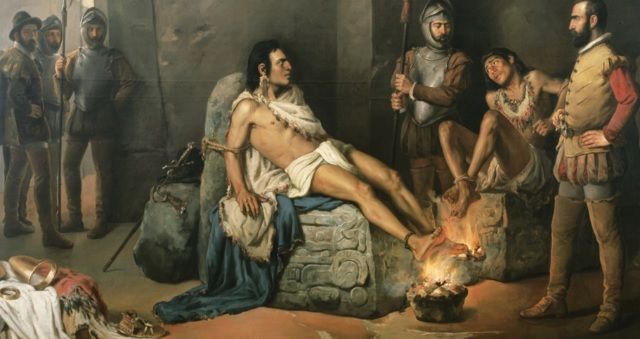The torment of Cuauhtémoc, the last Mexica emperor
This is the story of the torment of the last ruler of Mexico-Tenochtitlan - Cuauhtemoc. One of the noblest, brave, learned in war, daring, prudent, courageous, wise and loving.

This is the story of the torment of the last ruler of Mexico-Tenochtitlan - Cuauhtemoc. One of the noblest, brave, learned in war, daring, prudent, courageous, wise, and loving; these were some of the characteristics required to be named Huey tlatoani, the highest ruler of Mexico-Tenochtitlan.
These qualities were found in Cuauhtémoc, a young man between 18 and 25 years of age who had military experience and was part of the royalty as the son of the tlatoani Ahuízotl. Therefore, according to Tenochca tradition, he was invested in 1521 as Huey tlatoani after the death of Cuitláhuac and the fall of Moctezuma Xocoyotzin.
The governor's temperament was demonstrated on diverse occasions and when taking the power his vision was centered on expelling the Spaniards and preventing that these were established in the dominions of the Mexica empire. Cuauhtémoc worked to strengthen the city and the army to close the lines against the invaders.
However, Hernán Cortés and his men put a stop to his plans when, after his historic defeat known as the Sad Night, aided by the Tlaxcalans, they initiated an affront that concluded in the surrender of the Mexica empire on August 13, 1521.
This date coincides with the capture of Cuauhtémoc, who, when taken to Cortés' headquarters, asked the conquistador to be killed with the dagger in his belt, as he preferred to die rather than not fulfill the objective of defending his people from invasion and ignominy.
Once imprisoned, he was questioned about the destiny of the gold that was taken from the Spaniards during the Sad Night, when the squadron planned to flee Tenochtitlan in canoes loaded with plundered treasures.
To obtain information about the location of what is known as the Treasure of Moctezuma, and as punishment for his plans of rebellion, Cuauhtémoc was subjected to torture. The Huey tlatoani had his feet burned so that he would confess the location of the treasure; however, the story goes that with heroic courage he endured the mistreatment and refused to reveal information saying, "Am I in some delight or bath?"
This torture is known as the Torment of Cuauhtémoc.
In later years Cuauhtémoc lived as a prisoner of Cortés and was used for his political purposes until the Spaniard was informed of the Huey tlatoani's alleged plans to start a rebellion that would erupt with the murder of the conquistador and culminate in the banishment of the colonizers.
The conspiracy theory was accepted by Cortés since Cuauhtémoc still represented an important figure of authority among the people of México-Tenochtitlán. Therefore, Cortés, in the middle of an expedition in Honduras, ordered Cuauhtémoc to be assassinated, who was hanged in a pochote tree on February 28, 1525.
The eagle that descended, meaning Cuauhtémoc, became a heroic figure in our country and his name became synonymous with bravery. Cuauhtémoc, a symbol of serenity, sacrifice, and tireless struggle.




